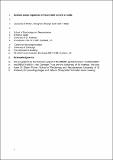Files in this item
Sodium pump regulation of locomotor control circuits
Item metadata
| dc.contributor.author | Picton, Laurence D. | |
| dc.contributor.author | Zhang, HongYan | |
| dc.contributor.author | Sillar, Keith T. | |
| dc.date.accessioned | 2018-05-24T23:32:45Z | |
| dc.date.available | 2018-05-24T23:32:45Z | |
| dc.date.issued | 2017-08-04 | |
| dc.identifier | 250221098 | |
| dc.identifier | 41e96353-e0c1-4ce8-886a-805f70d07de4 | |
| dc.identifier | 28539392 | |
| dc.identifier | 85026913761 | |
| dc.identifier | 000408102700033 | |
| dc.identifier.citation | Picton , L D , Zhang , H & Sillar , K T 2017 , ' Sodium pump regulation of locomotor control circuits ' , Journal of Neurophysiology , vol. 118 , no. 2 , pp. 1070-1081 . https://doi.org/10.1152/jn.00066.2017 | en |
| dc.identifier.issn | 0022-3077 | |
| dc.identifier.other | ORCID: /0000-0003-0171-3814/work/64393765 | |
| dc.identifier.uri | https://hdl.handle.net/10023/13532 | |
| dc.description | The authors are grateful for the financial support of the BBSRC (grant numbers: BB/M024946/1 and BB/JO1446X/1), the Carnegie Trust and the University of St Andrews. | en |
| dc.description.abstract | Sodium pumps are ubiquitously expressed membrane proteins that extrude three Na+ ions in exchange for two K+ ions using ATP as an energy source. Recent studies have illuminated additional, dynamic roles for sodium pumps in regulating the excitability of neuronal networks in an activity-dependent fashion. Here we review their role in a novel form of short-term memory within rhythmic locomotor networks. The data we review derives mainly from recent studies on Xenopus tadpoles and neonatal mice. The role and underlying mechanisms of pump action broadly match previously published data from an invertebrate, the Drosophila larva. We therefore propose a highly conserved mechanism by which sodium pump activity increases following a bout of locomotion. This results in an ultraslow afterhyperpolarisation (usAHP) of the membrane potential that lasts around 1 minute, but which only occurs in around half the network neurons. This usAHP in turn alters network excitability so that network output is reduced in a locomotor interval-dependent manner. The pumps therefore confer on spinal locomotor networks a temporary memory trace of recent network performance. | |
| dc.format.extent | 1982732 | |
| dc.language.iso | eng | |
| dc.relation.ispartof | Journal of Neurophysiology | en |
| dc.subject | Locomotion | en |
| dc.subject | Sodium pumps | en |
| dc.subject | Central pattern generator | en |
| dc.subject | Motor memory | en |
| dc.subject | Spinal cord | en |
| dc.subject | BF Psychology | en |
| dc.subject | QH301 Biology | en |
| dc.subject | RC0321 Neuroscience. Biological psychiatry. Neuropsychiatry | en |
| dc.subject | T-DAS | en |
| dc.subject.lcc | BF | en |
| dc.subject.lcc | QH301 | en |
| dc.subject.lcc | RC0321 | en |
| dc.title | Sodium pump regulation of locomotor control circuits | en |
| dc.type | Journal article | en |
| dc.contributor.sponsor | Carnegie Trust | en |
| dc.contributor.institution | University of St Andrews. School of Psychology and Neuroscience | en |
| dc.contributor.institution | University of St Andrews. Institute of Behavioural and Neural Sciences | en |
| dc.identifier.doi | 10.1152/jn.00066.2017 | |
| dc.description.status | Peer reviewed | en |
| dc.date.embargoedUntil | 2018-05-24 | |
| dc.identifier.grantnumber | 50273 | en |
This item appears in the following Collection(s)
Items in the St Andrews Research Repository are protected by copyright, with all rights reserved, unless otherwise indicated.

